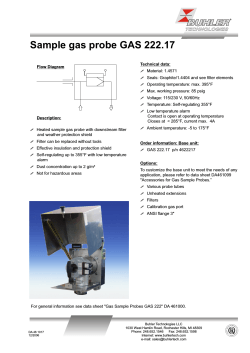
PARTICLE FILTER ADAPTATION BASED ON EFFICIENT SAMPLE SIZE Simandl
Introduction
Particle filter
Sample size adaptation
Numerical illustration
Conclusion
PARTICLE FILTER ADAPTATION BASED ON
EFFICIENT SAMPLE SIZE
ˇ
Ondˇrej Straka and Miroslav Simandl
Research Centre Data, Algorithms, and Decision Making
Department of Cybernetics
University of West Bohemia in Pilsen
Czech Republic
SYSID 2006, IFAC
ˇ
Ondˇrej Straka and Miroslav Simandl
University of West Bohemia in Pilsen, Czech Republic
PARTICLE FILTER ADAPTATION BASED ON EFFICIENT SAMPLE SIZE
Introduction
Particle filter
Sample size adaptation
Numerical illustration
Conclusion
Outline
1
Introduction
2
Particle Filter
3
Sample size adaptation
4
Numerical Illustration
5
Conclusion
ˇ
Ondˇrej Straka and Miroslav Simandl
University of West Bohemia in Pilsen, Czech Republic
PARTICLE FILTER ADAPTATION BASED ON EFFICIENT SAMPLE SIZE
Introduction
Particle filter
Sample size adaptation
Numerical illustration
Conclusion
Motivation
The problem how to specify a suitable sample size of the
particle filter is usually overlooked.
Particle filter usually considers unvarying sample size
while estimate quality varies.
It would be advantageous to know that certain number of
samples of the particle filter provide the same estimate
quality as a given number of samples drawn from the
filtering pdf directly. (although the filtering pdf is unknown
and being searched)
ˇ
Ondˇrej Straka and Miroslav Simandl
University of West Bohemia in Pilsen, Czech Republic
PARTICLE FILTER ADAPTATION BASED ON EFFICIENT SAMPLE SIZE
Introduction
Particle filter
Sample size adaptation
Numerical illustration
Conclusion
State estimation
Consider a discrete time stochastic system:
xk+1 = fk (xk , wk ),
zk
= hk (xk , vk ),
k = 0, 1, 2, . . .
k = 0, 1, 2, . . .
xk is nx dimensional state vector with p(x0 )
zk is nz dimensional measurement vector
wk is white noise with known p(wk )
vk is white noise with known p(vk )
fk (xk , wk ) and hk (xk , vk ) are known vector functions
The aim of state estimation here is to find the filtering pdf
T T
p(xk |zk ), where zk = [zT
0 , . . . zk ]
ˇ
Ondˇrej Straka and Miroslav Simandl
University of West Bohemia in Pilsen, Czech Republic
PARTICLE FILTER ADAPTATION BASED ON EFFICIENT SAMPLE SIZE
Introduction
Particle filter
Sample size adaptation
Numerical illustration
Conclusion
Particle filter
General solution of the filtering problem is given by the
Bayesian Recursive Relations (BRR).
Closed form solution of the BRR is available for a few
special cases only (e.g. linear Gaussian systems).
Thus an approximate solution of the BRR is usually
searched.
Solution of the BRR by the particle filter is based on
approximating the filtering pdf by a set of samples
(particles) and corresponding weights as
k
rNk (xk |z ) =
Nk
X
(i)
(i)
ωk δ(xk − xk ),
i=1
(i)
xk
(i)
ωk
- samples,
- normalized weights,
R
δ - the Dirac function (δ(x) = 0 for x 6= 0, δ(x)dx = 1).
ˇ
Ondˇrej Straka and Miroslav Simandl
University of West Bohemia in Pilsen, Czech Republic
PARTICLE FILTER ADAPTATION BASED ON EFFICIENT SAMPLE SIZE
Introduction
Particle filter
Sample size adaptation
Numerical illustration
Conclusion
(i)
Initialization
−1
0
draw {x0 }N
i=1 from p(x0 |z ) and
(i)
(i)
set ω0 ∝ p(z0 |x0 )
k =0
∗(i)
k
generate {xk }N
i=1 by resampling
Resampling
(i)
k
with replacement from {xk }N
i=1
∗(i)
(i)
according to P(xk
(i)
= xk ) = ωk
k =k +1
(i)
Sampling
k
draw new samples {xk }N
i=1 from
∗(1:Nk−1 )
π(xk |xk−1
, zk )
compute the weights
Weighting
ˇ
Ondˇrej Straka and Miroslav Simandl
(i)
k
{ωk }N
i=1 ∝
(i)
(i)
∗(i)
p(zk |xk )p(xk |xk−1 )
(i)
∗(i)
π(xk |xk −1 ,zk )
University of West Bohemia in Pilsen, Czech Republic
PARTICLE FILTER ADAPTATION BASED ON EFFICIENT SAMPLE SIZE
Introduction
Particle filter
Sample size adaptation
Numerical illustration
Conclusion
Sampling pdf’s
prior sampling pdf
(Gordon et al. 1993)
(1:ν)
π(xk |xk−1 , zk ) =
(i)
1
i=1 ν p(xk |xk−1 )
Pν
optimal sampling pdf
(Liu Chen 1998)
(1:ν)
π(xk |xk−1 , zk ) =
(i)
1
i=1 ν p(xk |xk−1 , zk )
Pν
auxiliary sampling pdf
(Pitt and Shephard 1999)
(1:ν)
π(xk |xk−1 , zk ) =
Pν
i=1
(i)
(i)
(xk−1 , zk )p(xk |xk−1 ),
(i)
(i)
(xk−1 , zk ) ∝ p(zk |µk )
ˇ
Ondˇrej Straka and Miroslav Simandl
University of West Bohemia in Pilsen, Czech Republic
PARTICLE FILTER ADAPTATION BASED ON EFFICIENT SAMPLE SIZE
Introduction
Particle filter
Sample size adaptation
Numerical illustration
Conclusion
Sample size
a key parameter significantly affecting estimate quality
usually time invariant, i.e. Nk = N
suitable specification of time-invariant sample size
addressed in
ˇ
Simandl
M. and Straka O.
´ Rao bound.
Nonlinear estimation by particle filters and Cramer
Proceedings of the 15th triennial world congress of IFAC, 79-84, 2002.
sample size is set according to a distance between the mean
´ Rao bound
square error and the Cramer
ˇ
Ondˇrej Straka and Miroslav Simandl
University of West Bohemia in Pilsen, Czech Republic
PARTICLE FILTER ADAPTATION BASED ON EFFICIENT SAMPLE SIZE
Introduction
Particle filter
Sample size adaptation
Numerical illustration
Conclusion
Current adaptive approaches
Fox D.
KLD sampling: Adaptive particle filter for mobile robot localization.
Advances in Neural Information Processing Systems, 2001.
probability that the KL distance between the true filtering pdf
and the approximate filtering pdf is lower than ε is studied
Koller D. and Fratkina R..
Using learning for approximation in stochastic processes.
Proc. of 15th Int. Conf. on Machine Learning, 287–295, 1998.
sum of likelihoods instead of sample size is kept constant
ˇ
Straka O. and Simandl
M.
Sample size adaptation for particle filters.
Proceedings of the 16th IFAC symposium on Automatic Control in Aerospace, 437–442, 2003.
assessing position of the generated samples according to the
current mesurement and sampling until a criterion is met
ˇ
Ondˇrej Straka and Miroslav Simandl
University of West Bohemia in Pilsen, Czech Republic
PARTICLE FILTER ADAPTATION BASED ON EFFICIENT SAMPLE SIZE
Introduction
Particle filter
Sample size adaptation
Numerical illustration
Conclusion
Sample size adaptation based on ESS
Idea:
to preserve Efficient sample size (ESS) and to adapt sample
size accordingly
Efficient sample size (ESS):
The ESS describes the number of samples drawn from the
filtering pdf necessary to attain the same estimate quality as Nk
samples drawn from the sampling pdf.
ESSk (Nk ) = Nk
1
1 + d(π, p)
(1:N
)
d(π, p) is the χ2 distance between π(xk |xk−1k−1 , zk ) and
p(xk |zk )
ˇ
Ondˇrej Straka and Miroslav Simandl
University of West Bohemia in Pilsen, Czech Republic
PARTICLE FILTER ADAPTATION BASED ON EFFICIENT SAMPLE SIZE
Introduction
Particle filter
Sample size adaptation
Numerical illustration
Conclusion
Sample size adaptation based on ESS (cont)
ESS can be derived in the following form
ESSk (Nk ) = Nk R
1
p(xk |zk )2
(1:N
)
π(xk |xk−1k −1 ,zk )
dxk
Sample size can be then specified as
Z
[p(xk |zk )]2
Nk = dNk∗
dxk e
(1:N
)
π(xk |xk−1k −1 )
Nk∗ is a prespecified ESS
ˇ
Ondˇrej Straka and Miroslav Simandl
University of West Bohemia in Pilsen, Czech Republic
PARTICLE FILTER ADAPTATION BASED ON EFFICIENT SAMPLE SIZE
Introduction
Particle filter
Sample size adaptation
Numerical illustration
Conclusion
Sample size adaptation based on ESS (cont)
The filtering pdf p(xk |zk ) is unknown but can be computed
using the BRR as:
Nk −1
p(xk |zk ) = C −1 p(zk |xk )
X
i=1
1
(i)
p(xk |xk−1 )
Nk−1
Sample size for the prior sampling pdf is
R
PNk −1 1
(i)
[p(zk |xk )]2 i=1
Nk−1 p(xk |xk−1 )dxk
∗
e
Nk = Nk d R
PNk −1 1
(i)
2
[ p(zk |xk ) i=1
Nk −1 p(xk |xk−1 )dxk ]
the integrals - usually intractable for nonlinear or nongaussian systems
- can be approximated using the MC method
- as Nk ≥ Nk∗ , the first Nk∗ samples can be used for approximation
ˇ
Ondˇrej Straka and Miroslav Simandl
University of West Bohemia in Pilsen, Czech Republic
PARTICLE FILTER ADAPTATION BASED ON EFFICIENT SAMPLE SIZE
Introduction
Particle filter
Sample size adaptation
Numerical illustration
Conclusion
System
xk+1 = xk − 0.2 · xk2 + ek
zk = xk + vk
p(ek ) = N {ek : 0, 0.1}
p(vk ) = N {vk : 0, 0.0001}
p(x0 ) = N {x0 : 0, 0.001}
Particle filter
Sampling pdf
optimal sampling pdf
prior sampling pdf
auxiliary sampling pdf
filtering pdf
k = 0, 1, . . . 10, Nk∗ = 10
Criterion - MSE Πk = E[xk − xˆk ]2 , 1000 simulations
ˇ
Ondˇrej Straka and Miroslav Simandl
University of West Bohemia in Pilsen, Czech Republic
PARTICLE FILTER ADAPTATION BASED ON EFFICIENT SAMPLE SIZE
Introduction
Particle filter
Sample size adaptation
Numerical illustration
Conclusion
Results without sample size adaptation
2
6
10
10
4
10
2
0
Nk
MSE
10
10
1
10
−2
10
−4
10
−6
10
0
0
2
4
k
6
8
10
10
0
1
2
4
5
k
6
7
8
9
10
Sample size
Mean square error
solid dashed dot-dashed dotted stars ˇ
Ondˇrej Straka and Miroslav Simandl
3
optimal sampling pdf
prior sampling pdf
auxiliary sampling pdf
filtering pdf
´ Rao bound
Cramer
University of West Bohemia in Pilsen, Czech Republic
PARTICLE FILTER ADAPTATION BASED ON EFFICIENT SAMPLE SIZE
Introduction
Particle filter
Sample size adaptation
Numerical illustration
Conclusion
Results with sample size adaptation
−4
4
10
10
3
−5
Nk
MSE
10
10
2
10
1
10
−6
10
0
0
1
2
3
4
5
k
6
7
8
9
10
10
0
1
2
Mean square error
4
5
k
6
7
8
9
10
Sample size
solid -
dashed dot-dashed dotted stars ˇ
Ondˇrej Straka and Miroslav Simandl
3
optimal sampling pdf
prior sampling pdf
auxiliary sampling pdf
filtering pdf
´ Rao bound
Cramer
University of West Bohemia in Pilsen, Czech Republic
PARTICLE FILTER ADAPTATION BASED ON EFFICIENT SAMPLE SIZE
Introduction
Particle filter
Sample size adaptation
Numerical illustration
Conclusion
Conclusion
A new sample size adaptation technique was proposed
It is based on preserving the Efficient sample size.
The technique achieves the same MSE for all sampling
pdf’s.
Enumeration of the adapted sample size introduces almost
no extra computational overheads.
ˇ
Ondˇrej Straka and Miroslav Simandl
University of West Bohemia in Pilsen, Czech Republic
PARTICLE FILTER ADAPTATION BASED ON EFFICIENT SAMPLE SIZE
© Copyright 2025









